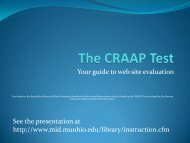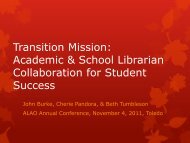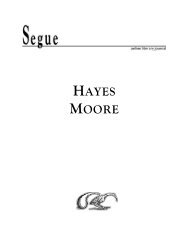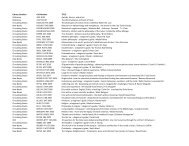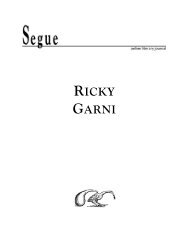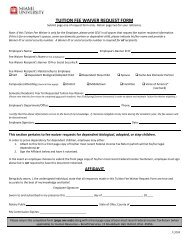Bibliography of Assessment Alternatives: Portfolios
Bibliography of Assessment Alternatives: Portfolios
Bibliography of Assessment Alternatives: Portfolios
Create successful ePaper yourself
Turn your PDF publications into a flip-book with our unique Google optimized e-Paper software.
teacher’s reflections. Teachers reported using more varied strategies for assessing student<br />
progress and improving literature-based language arts instruction. They also reported<br />
enhanced reflection about teaching, self-confidence, and sense <strong>of</strong> collegiality.<br />
(AL# 130.6TEAREE)<br />
Austin, Terri. Changing the View—Student-Led Parent Conferences, 1994. Available from:<br />
Heinemann, 361 Hanover St., Portsmouth, NH 03801.<br />
Although this short book is formally about student-led parent conferences (based on<br />
portfolios), it is really about much more. The author discusses the need (and how to) change<br />
the interactions between students and teachers on a day-to-day basis in the classroom, how to<br />
build the student skills needed for the parent conference, and how to better interact with<br />
parents. These are essential building blocks for student-led parent conferences and for<br />
building an environment in which students take control <strong>of</strong> their own learning. The author<br />
provides great ideas for:<br />
• Building a sense <strong>of</strong> community in the classroom<br />
• Communicating with parents<br />
• Clarifying what we value by discussing the criteria for success<br />
• Encouraging self-reflection<br />
• Grading<br />
• Actually setting-up and doing the conferences<br />
• Portfolio logistics and management<br />
The book contains lots <strong>of</strong> letters, student work, student dialogue, and self-reflections. No<br />
technical information is included.<br />
(AL# 150.6CHAVIS)<br />
Bailey, Jane, and Jay McTighe. Reporting Achievement at the Secondary Level: What and<br />
How. Located in: Thomas R. Guskey, Ed., ASCD Year Book 1996—Communicating<br />
Student Learning, 1996, Chapter 10, pp. 119-140. Available from: Association for<br />
Supervision and Curriculum Development, 1250 N. Pitt St., Alexandria, VA 22314,<br />
(703) 549-9110, fax (703) 299-8631.<br />
The authors show multiple examples <strong>of</strong> grading and reporting systems at the secondary level<br />
that are changing to more accurately reflect student achievement. They provide a nice<br />
framework for describing grading and reporting systems—what is assessed (content); why it<br />
is assessed (report progress, identify students for special programs, etc.); how it is assessed<br />
(grades, percentages, checklists, rating scales, written narratives, work samples, etc.); and<br />
who is the audience (parents, students etc.) The authors show examples <strong>of</strong> each type and<br />
discuss their advantages and disadvantages. Their classification scheme provides a useful<br />
way to think about grading issues and their discussion <strong>of</strong> advantages and disadvantages is<br />
good; some <strong>of</strong> the samples chosen to illustrate a method, e.g., portfolios, is a little weak.<br />
<strong>Assessment</strong> Resource Library, (503) 275-9582 5 Portfolio <strong>Bibliography</strong><br />
(formerly Test Center) NWREL, December 1996




